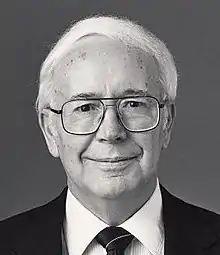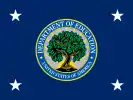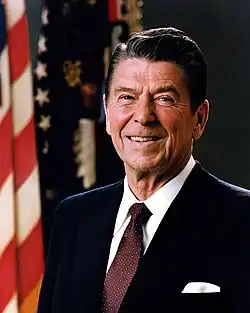Terrel Bell
Terrel Howard Bell (November 11, 1921 – June 22, 1996) was the Secretary of Education in the Cabinet of President Ronald Reagan.[1][2] He was the second Secretary of Education, following Shirley Hufstedler.
Terrel Bell | |
|---|---|
 | |
| 2nd United States Secretary of Education | |
| In office January 22, 1981 – December 31, 1984 | |
| President | Ronald Reagan |
| Preceded by | Shirley Hufstedler |
| Succeeded by | William Bennett |
| United States Commissioner of Education | |
| In office June 1974 – July 1976 | |
| President | Richard Nixon Gerald Ford |
| Preceded by | John Ottina |
| Succeeded by | Edward Aguirre |
| Personal details | |
| Born | Terrel Howard Bell November 11, 1921 Lava Hot Springs, Idaho, U.S. |
| Died | June 22, 1996 (aged 74) Salt Lake City, Utah, U.S. |
| Resting place | Larkin Sunset Gardens Sandy, Utah |
| Political party | Republican |
| Spouse(s) | Betty Fitzgerald |
| Children | 4 sons |
| Education | Albion (ID) Normal (BA) University of Idaho (MA) University of Utah (PhD) |
| Military service | |
| Allegiance | |
| Branch/service | |
| Rank | |
| Battles/wars | World War II |
Early life and career
Bell was born in Lava Hot Springs, Idaho, on November 11, 1921; at age eight, his father died.[3] Bell graduated from Lava Hot Springs High School in 1940,[4] and the Albion State Normal School in 1946. After this he served as a school superintendent of various schools in Idaho and Wyoming.
Bell spent much of his professional career in Utah. He served as a sergeant in the Marine Corps during World War II and returned to Idaho to get his education. After earning a B.A. in Albion in 1946, Bell started a career as a high school teacher and bus driver.
He earned an M.A. from the University of Idaho in Moscow in 1954, and a Ph.D. in education from the University of Utah in Salt Lake City in 1961. Bell also served as Utah's Commissioner of Higher Education and the superintendent of Weber School District in Utah from 1958 to 1962.
National Commissioner of Education
Bell served as the United States Commissioner of Education (prior to the creation of the cabinet position) under Presidents Richard Nixon and Gerald Ford from 1974 to 1976.
U.S. Secretary of Education
Appointed to the Reagan cabinet in 1981, Bell was expected to preside over the dismantling of the Department of Education,[2] but he ran into the legal requirement that such a dismantling required legislation. He was well-known, admired, and respected in education circles, having risen from high school teacher through college professor to administrative positions. Bell stood out as a humble man in an administration of moneyed people—he drove a U-Haul truck from Utah to Washington when he moved, as political appointees did not get reimbursed for moving expenses.[2]
In 1981, Bell convinced Reagan to appoint a commission to study excellence in education. The 1983 report of the National Commission on Excellence in Education, titled A Nation at Risk, started the drive for education reform with its conclusions, which included the claim that the nation was threatened by "a rising tide of mediocrity."[5]
Resignation and later life
Though education's importance was highlighted by the reform drive, Reagan continued to try to reduce funding at the Department of Education. Bell served for Reagan's first term, resigning effective December 31, 1984.[6][7] Bell was succeeded by Bill Bennett and returned to Salt Lake City to join the faculty at the University of Utah. In 1988, he published his memoir entitled The Thirteenth Man: A Reagan Cabinet Memoir.
Bell published seven other books during his career, covering topics such as improving child intellectual development and reforming the educational process. His last book in 1993, written with his business partner Dr. Donna Elmquist at his nonprofit company T.H. Bell and Associates in Salt Lake City, made new recommendations for improving the US education system.
"There are three things to emphasize in teaching: The first is motivation, the second is motivation, and the third is (you guessed it) motivation." Terrel H. Bell, U.S. Secretary of Education, 1981–1985 (Bell, 1995)
Personal
Bell married Betty Ruth Fitzgerald in 1957, and they had four sons: Mark F., Warren T., Glenn M., and Peter F. Bell.
Death
Bell died in his sleep at age 74 of pulmonary fibrosis at his home in Salt Lake City in 1996;[1] he is interred in Larkin Sunset Gardens in Sandy, Utah.
Terrel H. Bell Award
The Department of Education gives an award named after Bell to recognize "outstanding school leaders and the vital role they play in overcoming challenging circumstances." On November 3, 2009, the award was given to eight U.S. public school principals. Concurrent with the award, the department issued a press release which stated, "The late Secretary Terrel H. Bell held education as his highest priority, trusting that all students would find it their personal key to success as he had."[8]
See also
![]() Biography portal
Biography portal
![]() World War II portal
World War II portal
References
- "T.H. Bell – Ex-cabinet member and educator dies at 74". Deseret News. (Salt Lake City, Utah). June 23, 1996. Retrieved August 24, 2018.
- Rosenfeld, Megan (April 5, 1981). "For whom Bell toils". Washington Post. Retrieved August 24, 2018.
- Encyclopedia of Latter-day Saint History - Bell, Terrel H
- McCarthy, John (May 15, 1983). "UI grads hear Bell, governor". Lewiston Morning Tribune. (Idaho). p. 1C.
- A Nation at Risk. National Commission on Excellence in Education. April 1983.
- Thomas Ferraro (November 8, 1984). "Education Secretary Terrel Bell told his staff today he..." UPI. Retrieved December 29, 2016.
- "List of Education Secretaries". Archived from the original on 2016-12-30. Retrieved December 29, 2016.
- "Terrel Bell Award for Outstanding School Leadership Presented to Eight Principals" (Press release). U.S. Department of Education. November 3, 2009. Retrieved March 3, 2010.
- "Secretary of Education: Terrel H. Bell (1981 – 1984)". Miller Center of Public Affairs, University of Virginia. Miller Center of Public Affairs, University of Virginia. Retrieved 2017-03-30.
- The World Almanac 1997, Obituaries, p. 74.
External links
- Nomination as Secretary of Education
- University of Utah – Terrel Bell
- Terrel Bell at Find a Grave
- Appearances on C-SPAN
| Political offices | ||
|---|---|---|
| Preceded by John Ottina |
United States Commissioner of Education 1974–1976 |
Succeeded by Edward Aguirre |
| Preceded by Shirley Hufstedler |
United States Secretary of Education 1981–1985 |
Succeeded by Bill Bennett |

